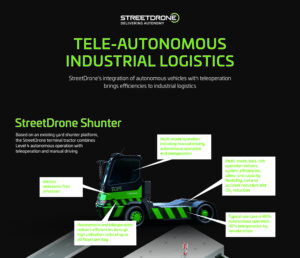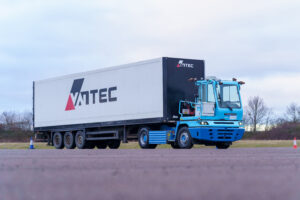Are you looking to improve the efficiency and performance of your distribution centre? Are you searching for automation technology that can help reduce operational costs, eliminate labour-intensive processes – while also improving customer service and satisfaction?
If so, then automation is a smart option. However, with an overwhelming number of different types of automation technologies on offer, it can be difficult to know where to begin. In this blog post we’ll provide some insight into how you should go about selecting the right technology for your business needs. Read on and learn how to pick the right autonomous solutions that will save you time and money in the long term!
Understand the basics of automation technologies and their advantages
Automation technologies have been increasingly adopted across various industries, and transportation is no exception. Autonomous yard tractors, lorries, and trucks are some of the most impressive automation technologies recently developed in this sector. These technologies offer numerous advantages, including improved efficiency, reduced labor costs, and increased safety.
By eliminating the need for human drivers, these technologies can operate continuously and perform tasks with remarkable accuracy. With the ability to constantly monitor their surroundings and react accordingly, these vehicles are capable of reducing accidents caused by human error. As businesses continue to seek ways to improve their operations, automation technologies like autonomous yard tractors, lorries, and trucks are likely to become even more prevalent.
Identify the objectives of the automation technology in terms of cost, efficiency and safety
The objectives of automation technology in the transportation industry are manifold, with cost, efficiency and safety chief among them. Autonomous electric trucks, for instance, offer significant cost savings as they operate without drivers, and cut fuel costs, the biggest expenditure for trucking firms.
Another advantage of automation technology is its ability to improve efficiency, reducing the time it takes to load and unload goods at warehouses and terminals.
With the transportation industry adopting net-zero emission standards, the urgency to adopt sustainable practices has never been more pressing, and autonomous technology can help to reduce CO2 emissions through its energy-efficient operations.
In addition, automation technology can help to ensure greater safety standards by minimising human error, reducing the risk of accidents and injuries.
With all these benefits, it is no wonder that the use of automation technology in the transportation industry is on the rise, and its applications are expected to continue to expand.

Analyse key performance indicators (KPIs) that will be impacted by automation implementation
As more and more international businesses embrace automation, it’s important to analyse the key performance indicators that will be impacted.
One of the most significant benefits of automation is the increased efficiency that it brings to your operations. By automating your tasks, you save time, energy, and money, which can be reinvested in other areas of the business.
Another important factor to consider is the positive impact on the environment. Autonomous trucks contribute to drastically reduced emissions; the IEA says “electric vehicles” is one category that is on track to meet their Net Zero Emissions by 2050 Scenario, as road transport accounts for 16% of global emissions. This helps businesses meet their sustainability goals and contribute to building a greener future.
Research different automation solutions available on the market and consider whether they meet your requirements
As businesses strive towards greater efficiency in their operations, automation has emerged as a game-changer. There are several automation solutions available on the market and research into the various options can seem overwhelming.
Autonomous trucks stand out among the available options for regional distribution centres. Autonomous yard tractors have become increasingly popular in recent times as they provide a safe and efficient way of transporting goods in slow, geo-fenced environments.
By tackling the issue of scarce human drivers, autonomous trucks offer significant cost savings, while consolidating their role in the future of the logistics industry. Martin Kendall, managing director at Vantec Europe, said about the autonomously and remotely driven trucks delivering parts at the Nissan car plant in Sunderland that they have the potential to create, rather than destroy, opportunities: “More needs to be done to get young people involved in logistics and managing lorries and doing that through a tele-ops route is hugely exciting. Further down the line, there’s no reason why that job couldn’t be done out of your bedroom. So, it’s not about job threat. It’s about job creation and ability, from an upskilling point of view, for today’s drivers, And there’s a reason to stay in, or get into, logistics.”
Regional distribution centres are also equipped with a plethora of other automated solutions such as conveyor belts and robotic arms, enhancing the speed and accuracy of order picking and ensuring the timely delivery of goods.
As you consider your automation requirements, these solutions offer exciting possibilities to explore.
Assess the costs associated with automating different processes in your distribution centre
In today’s fast-paced world, distribution centres are constantly looking for ways to streamline their operations and improve efficiency. One way to do this is through automation. But what exactly are the costs associated with automating different processes in your distribution centre?
It’s important to consider not only the upfront costs of purchasing and installing the equipment, but also the ongoing maintenance and operational expenses.
Additionally, you’ll need to factor in the cost of training your employees on how to use the new technology. While automation can bring many benefits, it’s important to carefully assess these costs before making any decisions.

Develop a plan for training staff to use any new technology introduced in order to increase efficiency
As businesses continue to incorporate new and innovative technologies, it is crucial that their employees are properly trained to use them. Upskilling workers is an essential step in maximising the potential benefits of any new technology. This is especially important when it comes to teleoperation and remote drivers.
These technologies have the potential to greatly increase efficiency, but only if staff are properly trained and equipped with the necessary skills and knowledge. Developing a plan for training staff when introducing new technologies is crucial to ensuring that the implementation is successful and that your business is reaping all of the possible benefits.
Automation technologies can have a significant impact on business operations in terms of safety, efficiency and cost. It is important to understand the basics of automation technology, as well as analyse the key performance indicators that could be impacted when introducing automation into your distribution centre.
You should also consider researching different solutions on the market and assessing any associated costs with automating processes. Don’t forget to develop a plan for training staff members to use any new technology prior to deployment, in order to ensure they are confident with it and the benefits it brings.
Implementing autonomously and remotely driven fleets of vehicles can be a great way to improve the efficiency of your regional distribution centre operations.
If you’re looking for trusted and reliable autonomous and teleoperation technologies, learn more about the autonomous yard tractor we have developed for our partners Vantec to deliver parts to the Nissan car plant in Sunderland. Learn more about our technologies guaranteeing safe, efficient and sustainable autonomous and remote driving.




